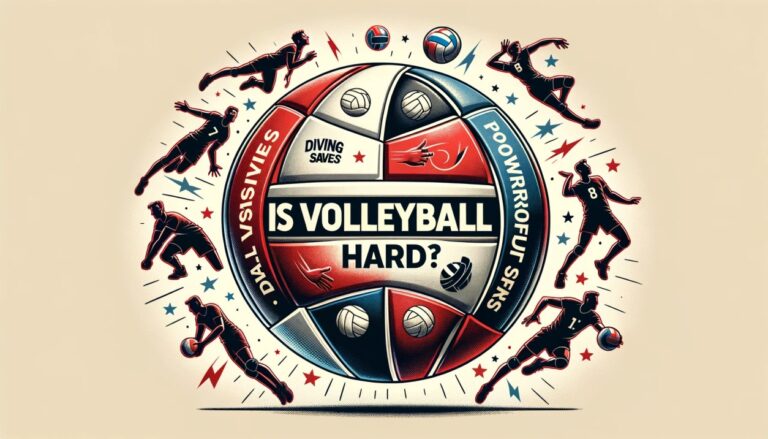4-2 Volleyball Rotation: Your Complete Guide
Introduction
In this article, complete information about 4-2 Volleyball Rotation is given. we’ll dive deep into the world of 4-2 volleyball rotation. We’ll explore what it is, why it’s called 4-2, and how it compares to other common rotations like 5-1 and 6-2. By the end, you’ll know the pros, cons, and strategies to make the most of this rotation system.
What is 4-2 Volleyball Rotation?
Definition and Basics
- The 4-2 rotation involves four hitters and two setters on the court.
- It’s a straightforward rotation system that’s often used by beginner and intermediate teams.
Why It’s Called 4-2
- The name comes from the number of hitters (4) and setters (2) on the court at any given time.
Comparison with Other Rotations
- 5-1 Rotation: Involves one setter and five hitters. More complex and requires specialized roles.
- 6-2 Rotation: Features two setters like 4-2 but offers more offensive options.

Advantages of 4-2 Volleyball Rotation
- Simplicity for Beginners: Easier to understand and implement, making it great for newcomers.
- Less Specialized Positions: Players don’t have to specialize too much, offering more flexibility.
- Easier to Implement: With fewer specialized roles, it’s quicker to get a team up and running.
- Ideal for Teams with Strong Front-Row Players: If your team has a strong front row, this rotation can maximize their impact.
Disadvantages of 4-2 Volleyball Rotation
- Limited Offensive Options: With only two setters, your offensive plays are somewhat restricted.
- Predictability: Opponents can more easily predict your plays, making it easier to defend against.
- Not Ideal for Teams with Strong Setters: If you have strong setters, you might be better off with a 5-1 or 6-2 rotation.
How to Implement 4-2 Volleyball Rotation
Step-by-Step Guide
- Identify Your Setters and Hitters: Know who will play what role.
- Initial Positioning: Place your setters in positions 1 and 4, and your hitters in the remaining positions.
- Rotation: Rotate clockwise after each serve.
Positioning of Players
- Setters should be in the back row to set up plays.
- Hitters should be ready to spike or block in the front row.
Tips for Smooth Transitions
- Communication is Key: Always call out before and after rotating.
- Practice Makes Perfect: The more you practice, the smoother your rotations will get.
Strategies for 4-2 Volleyball Rotation
Offensive Strategies
- Quick Sets: Utilize quick sets to catch the defense off guard.
- Cross-Court Hits: Use cross-court hits to diversify your offensive plays.
- Dump Shots: If you’re a setter in the front row, a well-timed dump can be a game-changer.
Defensive Strategies
- Double Blocking: Use double blocking to cover more area and make it difficult for the opponent to score.
- Deep Court Coverage: Make sure your back row is ready to cover deep hits.
Tips for Serving and Receiving
- Underhand Serve: If you’re new, start with an underhand serve to ensure it goes over the net.
- Communication: Always call “mine” when you’re going for the ball to avoid collisions.
Common Mistakes and How to Avoid Them
- Misalignment: Make sure everyone knows their position before the serve.
- How to Avoid: Use hand signals or quick verbal cues.
- Poor Communication: This can lead to missed opportunities and errors.
- How to Avoid: Always talk to your teammates, before, during, and after plays.
- Timing Issues: Poor timing can ruin plays and lead to lost points.
- How to Avoid: Practice, practice, practice. Timing comes with experience.
FAQs
What is the difference between 4-2 and 6-2 volleyball rotation?
4-2 has four hitters and two setters, while 6-2 has six hitters and two setters who come in from the back row.
Is 4-2 rotation good for beginners?
Absolutely, its simplicity makes it ideal for those new to the game.
How do you transition from one rotation to another?
Rotations happen after winning a point on the serve. Players rotate clockwise.
What are some tips for mastering 4-2 rotation?
Communication, understanding player roles, and regular practice are key.
What is a 4-2 rotation in volleyball?
A 4-2 rotation in volleyball refers to a formation where there are four hitters and two setters on the court. This rotation is often used for its simplicity and is particularly popular among beginner and intermediate teams. In this setup, the setters are usually positioned in the back row, allowing them to set up plays for the hitters in the front row.
What is the 4-2 strategy in volleyball?
The 4-2 strategy in volleyball focuses on maximizing the strengths of having four hitters and two setters. Offensive strategies may include quick sets, cross-court hits, and dump shots. Defensive strategies often involve double blocking and deep court coverage.
The 4-2 rotation is generally easier to implement and requires less specialization among players, making it a good choice for teams that are still developing their skills.
What is the difference between a 4-2 and 6-2 rotation?
The primary difference between a 4-2 and a 6-2 rotation is the number of hitters on the court. In a 4-2 rotation, there are four hitters and two setters.
In a 6-2 rotation, there are six hitters and two setters, with the setters coming in from the back row to replace front-row hitters when it’s their turn to set. The 6-2 rotation offers more offensive options but is also more complex to implement.
What does a 6-2 mean in volleyball?
A 6-2 rotation in volleyball means that there are six hitters and two setters. The setters usually come in from the back row to replace front-row hitters when it’s their turn to set.
This rotation allows for a more dynamic offense but requires more specialized roles and better coordination among team members.
Is there a win by 2 rule in volleyball?
Yes, in most official volleyball games, there is a “win by 2” rule. This means that a team must win by at least two points to secure a set. This rule is in place to ensure that the winning team has a clear advantage over the opponent.
What is 444 in volleyball?
The term “444” is not a standard term in volleyball. It could be a team-specific code or strategy, but it’s not universally recognized in the sport.
What is a 5-1 in volleyball?
A 5-1 rotation in volleyball involves one setter and five hitters. The single setter is responsible for all setting duties, regardless of their position on the court. This rotation is more complex and requires players to have specialized roles, particularly the setter.
What is rotation 3 in volleyball?
Rotation 3 in volleyball refers to one of the six rotational positions that players move through during a match. The specific responsibilities and positioning of players in rotation 3 will depend on the overall rotation system being used (e.g., 4-2, 5-1, 6-2).
What is rotation 5 in volleyball?
Rotation 5 is another one of the six rotational positions in volleyball. As with rotation 3, the specific roles and positioning in rotation 5 will depend on the rotation system the team is using.
Is there a 5-2 in volleyball?
A 5-2 rotation is not a standard rotation system in volleyball. The most common rotations are 4-2, 5-1, and 6-2.
Is there a 5-second rule in volleyball?
There is no 5-second rule in official volleyball play. However, servers are generally expected to serve the ball within 8 seconds after the referee’s whistle in indoor volleyball.
What is a 2 pass in volleyball?
A “2 pass” is not a standard term in volleyball. Passing in volleyball is usually referred to as a “bump” or “underhand pass,” and it’s the action of directing the ball toward the setter or over the net using the forearms. The quality of passes is sometimes rated on a scale from 0 to 3, with 3 being a perfect pass that goes directly to the setter.
Conclusion
You’ve now got the lowdown on 4-2 volleyball rotation. From its advantages like simplicity and ease of implementation to its disadvantages like limited offensive options, you’re now equipped with the knowledge to decide if this rotation is right for your team. So why not give it a try? Your journey to becoming a volleyball pro might just start with mastering this rotation. Happy spiking!





